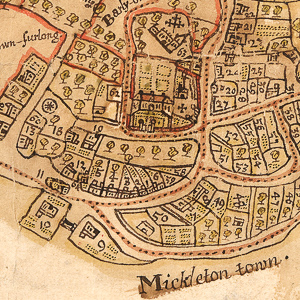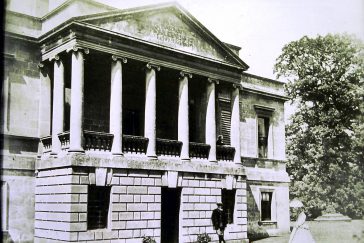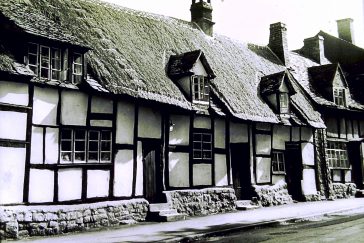
1698 Map of Mickleton (extract)
The earliest roads through the village were tracks formed during the 13th century. The White Way, which ran from Cirencester to Stratford, and the Saltway, which linked Droitwich to Stow-on-the-Wold. Six hundred years later turnpike roads were established and Toll Bars introduced at the Butts, Pauls Pike and Draycott Corner.
In 1349 the Black Death resulted in the death of half the population and this brought great social change for labouring folk (”villeins”) enabling them to bargain for wages. Shortage of labour meant that land was given over to sheep farming so giving impetus to the wool and weaving industries. Wealth created around this time meant that the squat dark Mickleton Church was renovated resulting in the space, light and loftiness which characterise its modern day appearance.
In the reign of King Edgar the Manor was Crown property, following which the Abbey of Eynsham held it until the Dissolution. In 1494 the Porter family held a long-term lease of the Manor and in 1513 Richard Porter established a Charity for support of the Church and School and endowed it with 29 acres of land known as Upper and Lower Church Pieces.
By 1571 the leasehold title had become so complex that arbitration was required between conflicting claims of members of the Porter and Hardwarde families. In 1591 the lease was surrendered to the Crown and in 1600 the building was sold to Sir Edward Fisher. However, the family encountered severe financial problems and sold the Manor to Richard Graves in 1656. His grandson, also Richard Graves was born there in 1677 and became the well known Scholar and Antiquary who collected much material relating to the Hundred of Kiftsgate . Richard’s second son, born in 1715, was a poet and translator whose friend William Shenstone, also a poet, landscaped the grounds and planted an avenue leading up Glyde Hill.
A portion of the original 17th century Manor house survives in the North Wing. This is defined by its two three-story gables with oval windows and finials. Georgian wings were added in the 18th century and the building was completed during the early 19th century.

Portico of Mickleton Manor, now Kiftsgate Court.
In 1891 the main library wing and portico was taken down, transported up Glyde Hill on a horse drawn railway, and rebuilt at Kiftsgate Court by order of Sidney Graves Hamilton. During the 19th century the then Lord of the Manor, Sir Maxwell Steel Graves, made provision for public water supplies within the village with the provision of stand pipes in the High Street (now the fountain) and at Tadpole. These were supplied from his Parks reservoir.
The early 20th century saw Mary Graves Hamilton as Lady of the Manor and in 1932 she gave half an acre of her land to the Parish for use as a cemetery. At the start of World War II gunports were cut into the Manor boundary wall on the High Street wall to cover attack from the West. Later, the Manor became St Hilliard’s School and has now been converted into four dwellings with beautiful views at the rear towards Meon.

Thatched cottages in High Street
A number of other 17th century buildings survive within the village. These include a mix of mostly timber frame and limestone buildings. A row of timber framed thatched cottages survives on the High Street and more can be found around the west end of Chapel Lane, near to Tadpole. Apart from one or two buildings being built in the 18th century the next main phase of development appears to have been during the 19th century.
Up until the Repeal of the Corn Laws in 1846 agriculture in and around the village was predominantly dairy, grazing and tillage. This was followed by corn and grain, which was in demand locally on account of its quality. Market gardening took hold at the end of the last century under the instigation of Mr Powell and John Taylor. This later was taken on by Joseph Webb in 1896 in the Canada Lane area of Mickleton. Towards the end of the 19th century milk and beef production was supplemented by market gardening, initially with the cultivation of tomatoes and then marrows, cucumbers and cauliflowers. This development was assisted by the introduction of pumped water after the First World War. By World War II 15 acres of glass houses were in use primarily for cauliflowers, lettuce and onions. Acres of greenhouses were built mainly around the area of Canada Lane and Broad Marston Lane. Others were dotted around the village. Following the decline in the market garden industry much of the land became under used and the glass houses became derelict. Until recent decades the village was very much characterised by its numerous orchards and garden areas. None of these glasshouses remain and the vast majority have now been replaced by modem housing developments.






No Comments
Add a comment about this page